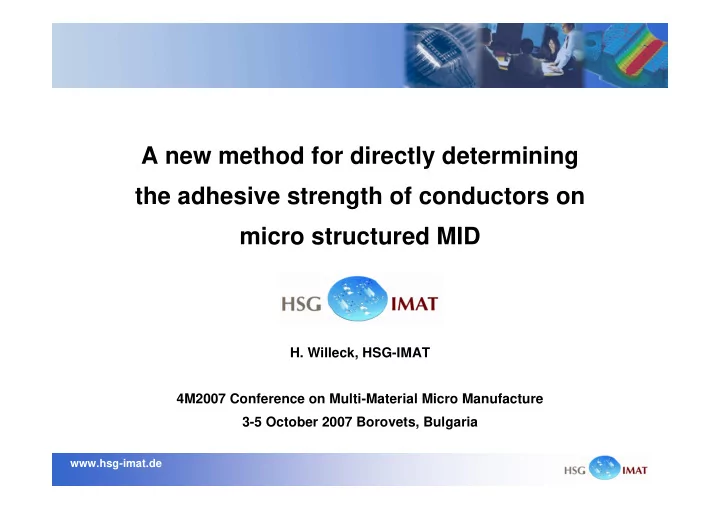

A new method for directly determining the adhesive strength of conductors on micro structured MID H. Willeck, HSG-IMAT 4M2007 Conference on Multi-Material Micro Manufacture 3-5 October 2007 Borovets, Bulgaria www.hsg-imat.de
Overview � Research objective � Established methods for determining the adhesive strength � New measuring principle � Design of the new measuring device � First results � Summary www.hsg-imat.de H. Willeck, HSG-IMAT 2
Research objective Directly determining the adhesive strength of conductors on MID (Moulded Interconnect Devices) � Adhesive strength is important for the reliability and hence an important quality feature. 10 mm � Typical geometry of conductors on MID: Rotation angle sensor in MID LDS technology (BMBF-Verbundvorhaben approx. 200 – 500 µm width, 10 – 20 µm thick IMDAKT ) � Established measurement methods are not suitable. www.hsg-imat.de H. Willeck, HSG-IMAT 3
Established methods for determining the adhesive strength Peel test Pull test Layer thickness > 20µm Metal areas with several mm² Required width > 0,5mm are required. Required length > 30mm F pull F Peel peel off hook hook soldered eye Metal layer/ conductor adhesive conductor movement of the substrate substrate � For geometry reasons these methods are not suited for determining the adhesive strength on MID parts www.hsg-imat.de H. Willeck, HSG-IMAT 4
New measuring principle � Detection of conductor profile and substrate tilt by scanning the conductor surface � Peel off the conductor with a micro peel off chisel � Acquisition of paths and forces � Extraction of the adhesive strength of the conductor z Reproduction of the force situation of micro peel peeltest and pull-sheartest with different off chisel y peel off chisel geometries and resolution metal of the force layer F y F z substrate Conductor- substrate interface movement www.hsg-imat.de H. Willeck, HSG-IMAT 5
Requirements for the measuring device � Suitable for conductors with 200 – 1000 µm width and 5 – 30 µm thickness � Range of forces to be detected approx. +/- 50 N, smallest forces ≈ 0,01 N � Very stiff mechanical design ( ≈ 1 N/µm) � High accuracy of the positioning system � Semi-automated measurements � Compensation of substrate tilt by profile detection of the conductor and substrate � Basic comparability to established measurement procedures www.hsg-imat.de H. Willeck, HSG-IMAT 6
Sensor and peel off unit Sensor housing Housing reinforcement Magnetic clamp Parallel spring suspension with piezoelectric load cell (z-component) Parallel spring suspension with piezoelectric load cell (y-component) Holder for the LVDT-deflection sensor for the profile detection Peel off chisel www.hsg-imat.de H. Willeck, HSG-IMAT 7
Design of the measuring device � Granite rack � High accuracy positioning system with multiple axes � Sensor and peel off unit � Peel off chisel � Optics for substrate adjustment and monitoring � Characteristics � Linearity: +/- 1.5 % FSO � Stiffness: ≈ 1 N/µm www.hsg-imat.de H. Willeck, HSG-IMAT 8
Peel off chisel geometry � Cutting edge radius r β : <2µm Chisel z cutting edge � Chip angle γ : 10° -60° γ � Different force situations y on the chisel blade r β � small angle: Fy correlates β α with shear force substrate � big angle: Fz correlates with peel force small chip angle big chip angle � Manufacturing 1. Milling 2. Hardening 3. Grinding Fy � � shear force � � Fy < Fz Fz ≈ ≈ 0 ≈ ≈ Fz � � peel force � � www.hsg-imat.de H. Willeck, HSG-IMAT 9
Results of peeled off copper conductors on FR4 substrate Conductor length: 5 mm, width: 500 µm, thickness: 35 µm, chip angle: 60° force [mN] y forces z forces y axis position [µm] www.hsg-imat.de H. Willeck, HSG-IMAT 10
Comparison of z forces with peel forces � Conductor length: 50 mm, width: 500 µm, thickness: 35 µm � The z forces are displayed as the absolute value of the z-forces force [mN] peel forces z forces y axis position [µm] www.hsg-imat.de H. Willeck, HSG-IMAT 11
Results of peeled off conductors on MID substrate � Conductor length: 5 mm, width: 500 µm, thickness: 10 µm, chip angle: 60° � Cu/NiP/Au on liquid crystal polymer (LCP) made by Laser-Direct- Structuring (LDS) www.hsg-imat.de H. Willeck, HSG-IMAT 12
Results of peeled off conductors on MID substrate Substrate after peel off process Peeled off conductor segments � Chisel was moving in the substrate- 100 µm conductor interface. www.hsg-imat.de H. Willeck, HSG-IMAT 13
Results of peeled off conductors on MID substrate 2000 YKraft [mN] y forces ZKraft [mN] z forces force [mN] Kraft [mN] 1500 1000 500 0 -500 -1000 0 500 1000 1500 2000 2500 y axis position [µm] Y-Tisch-Position [µm] www.hsg-imat.de H. Willeck, HSG-IMAT 14
Approaches for interpreting the results 1. Analysis of the maximum force of one segment 2. Energy analysis of the complete conductor 3. Energy analysis of single segments 3000 y forces 1. 2. 3. force [mN] Kraft [mN] z forces 2000 1000 0 segment width -1000 0 500 1000 1500 2000 y axis position [µm] Y-Tisch-Position [µm] www.hsg-imat.de H. Willeck, HSG-IMAT 15
Approaches for interpreting the results Comparison of approach 1 and 2 with results from the peel test Approach 1 average adhesive strength [N/mm] Approach 2 Peel test � � Correction factor for � � correlating with peel test necessary www.hsg-imat.de H. Willeck, HSG-IMAT 16
Summary � A device with a new measuring principle for determining the adhesive strength of conductors has been developed and built-up. � Results from conductors on printed circuit boards (FR4) of the new measuring principle show good correlation with the well known peel test. � Cu/NiP/Au-conductors on MID substrates crack into segments while being peeled off. � Forces during peel off process on MID-substrates are in the same magnitude than the forces during the peel test � a correlation via correction factor appears possible. www.hsg-imat.de H. Willeck, HSG-IMAT 17
Thanks for your attention! www.hsg-imat.de H. Willeck, HSG-IMAT 18
Recommend
More recommend